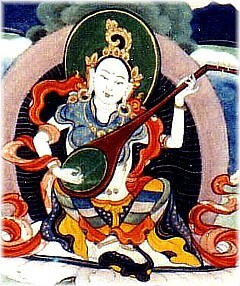Sarasvatī Meditation and Mantra
ཆོས་ཉིད་མཁའ་འགྲོའི་ཐུགས་ཐིག་ལས༔དབྱངས་ཅན་ལྷ་མོའི་བསྒོམ་བཟླས་བསྡུས་པ་བཞུགས་སོ༔
A Concise Meditation and Mantra Recitation of Sarasvatī
from the Heart-Essence of the Ḍākinī of Suchness (Chönyi Khandrö Tuktik)
revealed by Sera Khandro
དབྱངས་ཅན་ལྷ་མོའི་བསྒོམ་བཟླས་ནི༔ དང་པོ་སྐྱབས་སུ་འགྲོ་བ་ནི༔
Begin your practice of meditation on, and mantra recitation of, Sarasvatī with refuge:
ན་མོ༔ བདག་གཞན་འགྲོ་དྲུག་སེམས་ཅན་རྣམས༔
namo, dakzhen dro druk semchen nam
Namo. I, along with all beings of the six realms,
མཆོག་གསུམ་ཀུན་འདུས་ངོ་བོ་ཉིད༔
chok sum kündü ngowo nyi
Take refuge in you, Sarasvatī,
དབྱངས་ཅན་ལྷ་མོར་སྐྱབས་སུ་མཆི༔
yangchen lhamor kyab su chi
Embodiment of the Three Jewels—
ངན་འགྲོའི་འཇིགས་ལས་བསྐྱབ་ཏུ་གསོལ༔
ngendrö jik lé kyab tu sol
Pray keep us from the fears of the lower realms!
ལན་གསུམ་དང་དེ་ནས་སེམས་བསྐྱེད་པ་ནི༔
Recite the above three times. Then take the pledge to awaken (bodhicitta) with:
ཧོཿ མར་གྱུར་འགྲོ་བ་ཀུན་དོན་དུ༔
ho, mar gyur drowa kün döndu
Ho. For the sake of all beings, who have each had the experience of being a parent to me—
སྨོན་པ་བྱང་ཆུབ་སེམས་དང་ནི༔
mönpa changchub sem dang ni
I generate the aspiration of bodhicitta
འཇུག་པ་ཕ་རོལ་ཕྱིན་པ་དྲུག༔
jukpa parol chinpa druk
And pledge to engage and accomplish
དེང་ནས་བརྩམས་ཏེ་བསྒྲུབ་པར་བགྱི༔
deng né tsam té drubpar gyi
The practice of the six perfect actions.
ལན་གསུམ་དང༔ ལྷ་བསྐྱེད་ནི༔
Recite the above three times. For the meditation upon the deity:
ཧྲཱིཿ རང་ཉིད་སྐད་ཅིག་དབྱངས་ཅན་ལྷ་མོའི་སྐུ༔
hrih, rangnyi kechik yangchen lhamö ku
Hrīḥ. Instantaneously I arise as Sarasvatī,
དཀར་གསལ་མདངས་ལྡན་ཞི་འཛུམ་མཚན་དཔེས་བརྒྱན༔
karsal dangden zhi dzum tsenpé gyen
Translucent white, peaceful and radiant as she smiles, adorned with the major and minor marks of perfection.
ཞལ་གཅིག་ཕྱག་གཉིས་པི་ཝཾ་མཉམ་པས་འཛིན༔
zhal chik chak nyi piwam nyampé dzin
She has one face and two hands that play a sitar.
རྩེ་བྲན་དར་དཔྱངས་རིན་ཆེན་རྒྱན་ཆས་མཛེས༔
tsedren dar chang rinchen gyenché dzé
Silken tassels hang from her jewel tiara.
ཞབས་གཉིས་པད་ཟླར་བརྐྱང་བསྐུམས་ཚུལ་དུ་བཞུགས༔
zhab nyi pé dar kyang kum tsul du zhuk
She sits on lotus and moon disk with her ankles crossed and knees drawn up.
དེ་ལྟར་གསལ་བའི་གནས་གསུམ་འབྲུ་གསུམ་ལས༔
detar salwé né sum dru sum lé
The three places of her body are each marked with a syllable,
འོད་འཕྲོས་སྐུ་གསུམ་རྒྱལ་བའི་ཞིང་ལ་ཕོག༔
ö trö ku sum gyalwé zhing la pok
From which light radiates to the myriad buddha-fields of the three kāyas
རྒྱལ་ཀུན་དབྱངས་ཅན་ལྷ་མོའི་རྣམ་པ་རུ༔
gyal kün yangchen lhamö nampa ru
And invites the awakened in the aspect of Sarasvatī.
སྤྱན་དྲངས་དམ་ཡེ་དབྱེར་མེད་རོ་གཅིག་གྱུར༔
chendrang damyé yermé ro chik gyur
The invoked wisdom merges with and becomes of one taste with me, the visualized deity;
རིག་སྟོང་བརྗོད་མེད་ལྷ་མོའི་རང་ཞལ་མཇལ༔
riktong jömé lhamö rang zhal jal
Awareness–emptiness, beyond all expression—behold the real face of the goddess.
གསལ་སྟོང་འགགས་པ་མེད་པའི་ངང་དུ་བཟླ༔
saltong gakpa mepé ngang du da
Within unimpeded emptiness-luminosity, I recite the mantra:
ཨོཾ་ཧྲཱིཾ་དེ་ཝི་པྲཛྙཱ་ཝཱརྡྷ་ནི་ཡེ་སྭཱ་ཧཱཿ
om hring déwi pradznya wardhani yé soha
Oṃ hrīṃ devi prajñā vārdhani ye svāhā
ཞེས་པར་རྒྱུན་དུ་བརྩོན་གྱུར་ན༔
དབྱངས་ཅན་ལྷ་མོ་འགྲུབ་ནས་ཀྱང༔
ཚེ་རབས་ཀུན་ཏུ་རྗེས་བཟུང་ནས༔
ཤེས་རབ་གཟུངས་ཐོབ་བློ་གྲོས་འཕེལ༔
ཐེ་ཚོམ་མེད་དོ་ས་མ་ཡ༔
If you recite this continuously with diligence
You will accomplish the goddess, Sarasvatī,
And be forever cared for by her,
Gain the dhāraṇī of wisdom and increased intelligence—
Of this there is no doubt! Samaya.
ཐུན་མཐར་ཉེར་སྤྱོད་ཀྱིས་མཆོད་ནས༔ བསྟོད་པ་ནི༔
At the conclusion of your meditation session make the traditional offerings and praise with:
ཧཱུྃ༔ དཀར་གསལ་སྟོན་ཟླའི་དཔལ་ལས་ལྷག་པར་མཛེས༔
hung, karsal tön dé pal lé lhakpar dzé
Hūṃ. Autumn’s full moon cannot eclipse your beauty,
ཤེས་རབ་བློ་གྲོས་གཟུངས་དང་སྤོབས་པ་འཆང༔
sherab lodrö zung dang pobpa chang
You hold wisdom’s dhāraṇī and speak with confidence and eloquence,
ཡོན་ཏན་རབ་རྫོགས་མཁྱེན་བརྩེའི་གཏེར་མངའ་བ༔
yönten rabdzok khyentsé ter ngawa
All qualities are perfected in you—for your mind is the very treasury of love and wisdom.
དབྱངས་ཅན་ལྷ་མོའི་སྐུ་གསུང་ཐུགས་ལ་བསྟོད༔
yangchen lhamö ku sung tuk la tö
Sarasvatī, I praise your body, speech and mind.
དགེ་བས་བདག་སོགས་སེམས་ཅན་མ་ལུས་པ༔
gewé dak sok semchen malüpa
Through this merit may all beings
འོག་མིན་དག་པའི་ཞིང་ལ་སྤྱོད་པར་ཤོག༔
womin dakpé zhing la chöpar shok
Come to enjoy the highest, Akaniṣṭha, pure realm.
ཅེས་ལྷ་མོའི་བསྒོམ་བཟླས་བསྡུས་པ་འདི་ཡང་སྔགས་བཙུན་ཙྪེ་ད་ཀས་དར་བཅས་བསྐུལ་ངོར། སུ་ཁའི་མིང་གིས་བྲིས་པའོ།། དགེའོ།།
This concise meditation on, and mantra recitation of, the goddess Sarasvatī, was requested, together with a silken scarf, by the monastic mantrika Chhedaka, and written by the one named Sukha. May it prove virtuous!
| Translated by Sean Price and edited for Lotsawa House, 2019.
Source:
kun bzang bde skyong dbang mo. "dbyangs can lha mo'i bsgom bzlas bsdus pa" In gsung 'bum/_kun bzang bde skyong dbang mo/. 6 vols. Chengdu: si khron dpe skrun tshogs pa/ si khron mi rigs dpe skrun khang, 2009. (BDRC W1PD108254) Vol. 3: 355–356
Version: 1.2-20220818
